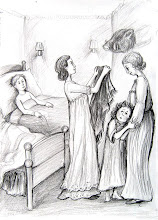Lilienfeld, Jane. "'The Horrors of Family Life': A Feminist Interrogation of the Politics of Codependence in To the Lighthouse." Reading Alcoholisms: Theorizing Character and Narrative in Selected Novels of Thomas Hardy, James Joyce, and Virginia Woolf. New York: St. Martin's, 1999. 159-232. Print.
Jane Lilienfeld’s article possesses a strong and central point of view, that being the negative societal beliefs within the Victorian era of women practicing codependency. More specifically, Lilienfeld discusses Virginia Woolf’s family, particularly Woolf’s mother, to further elaborate on the societal values of Victorian practice that are present within the novel To the Lighthouse. By speaking in great detail about Woolf’s mother, and then showing similarities between both mother and Mrs. Ramsay, Lilienfeld states how a Victorian woman was expected to be obedient, submissive and codependent upon their husbands, fathers and sons. Lilienfeld explains the reasoning of Mrs. Ramsay’s behavior within the novel by saying, “codependence is not only a mechanism for her survival, but that certain narrative techniques as well can be interpreted as similar to strategies of codependence” (192). In contrast to Mrs. Ramsay’s character that is acceptable and married due to her codependence, Lily Briscoe remains single due to the fact that she refuses be codependent to men. Lilienfeld then contrasts the choices made between the characters of Mrs. Ramsay and Lily, only to revert back to showing similarities between them, for Lily is codependent upon her art as Mrs. Ramsay is codependent on her husband.
This source has great potential in adding information to the research question’s answer. The way in which this article aids is due to the fact that it provides specific insight into the two main female characters in To the Lighthouse. By explaining Mrs. Ramsay’s codependency upon her husband, and by contrasting that with Lily Briscoe’s need to record her vision through painting, this source reveals the need that Woolf had in recording her vision through writing, which reveals that both Lily and Woolf become codependent upon their art. Lilienfeld states, “Mrs. Ramsay and Lily Briscoe have searched for a way to maintain the complexities of truth without dividing things into opposites,” which can reference what Woolf attempted to do within her narrative. Though unable to aid in the artistic process that Lily experiences, this article is able to contribute to the research question due to the fact that it explains the expectations of women during the Victorian era, which reveals in Woolf’s narrative the searching for what is true and free.
Subscribe to:
Post Comments (Atom)



No comments:
Post a Comment